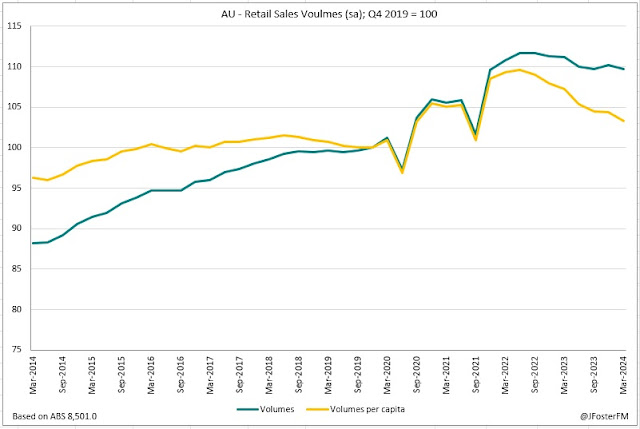A stronger-than-expected rise in employment in April (38.5k) was unable to keep a lift in the unemployment rate at bay, increasing to a 3-month high of 4.1%. Momentum in employment remains strong but tightness in the labour market has eased, consistent with wages growth starting to lose heat.
By the numbers | April
- Employment increased by a net 38.5k in April, above the 20k consensus following a 5.9k fall in March (revised from -6.6k).
- The unemployment rate lifted to 4.1% (vs 3.9% expected) from a revised 3.9% in March (3.8% reported initially).
- Labour force participation increased from 66.6% to 66.7%, just below the record high of 67% from last November.
- Hours worked were unchanged month-on-month but are down 0.8% over the year.
The details | April
Employment rebounded from a weak March figure (-5.9k) rising by 38.5k in April (full time -6.1k and part time +44.6k). This outcome was near the top end of the range of forecasts (-10k to +45k), though conviction going into today's report given the timing of the survey coincided with Easter and school holiday periods. Although employment outcomes in recent months have been volatile, the underlying trend shows that employment has strengthened since the start of the year. In fact, employment for the 3 months to April averaged an increase of 50.2k per month - its strongest clip since May last year.
Rising momentum in employment helped keep the unemployment rate below 4% over the past couple of months; however, in April it ticked back up to 4.1% - in line with its level from January. In addition, both the underemployment rate (6.5% to 6.6%) and the total underutilisation rate (10.3% to 10.7%) rose in April. These increases were driven by two factors 1) the labour force increased by 68.8k (reflected in the participation rate rising from 66.6% to 66.7%), which outpaced the net gain in employment (38.5k), and 2) hours worked in April were flat in month-on-month terms. Overall, these metrics on spare capacity in the labour market are still constructive, but they imply the level of tightness has eased over the past year or so - an assessment validated by the apparent peaking in wages growth reported yesterday.
The broader dynamic that has been playing out is that employment growth has converged with growth in the working-age population - in RBA speak, labour demand has been coming into balance with labour supply.
Monthly hours were reported flat in April, though it is probably best to take this with a grain of salt given the effect of Easter and school holidays. The ABS's seasonal adjustment processes are designed to mitigate such effects; however, the post-pandemic labour market is very different from the pre-pandemic one. For instance, the ABS noted the timing of Easter in 2024 closely aligned with 2018; back then, hours worked rose 1% month-on-month but were flat this year.
In summary | April
My takeaway from today's report is that it is unlikely to change the RBA's assessment of the labour market; that being that conditions have moved away from peak levels of tightness but are still robust overall. The headline increase to 4.1% unemployment was higher than expected; however, the ABS noted in today's release that more people than usual for this time of year were waiting to start new jobs. A similar effect in February (while more pronounced than in April) contributed to a very large rise in employment and a fall in the unemployment rate. Absent a shock, there is still good reason to be optimistic that the robust momentum in employment growth can be sustained and hold the unemployment rate around current levels.





































